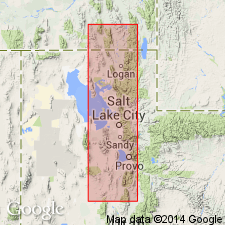
- Usage in publication:
-
- Pokes Point Alloformation
- Modifications:
-
- Named
- Reference
- Dominant lithology:
-
- Gravel
- Sand
- AAPG geologic province:
-
- Great Basin province
Summary:
Name applied to one of four Pleistocene lake cycle deposits differentiated in this report in the Bonneville basin. Correlation of deposits in basin based on isoleucine epimerization in carbonate fossils and radiocarbon ages. Older deposits assigned to pre-Pokes Point deposits. Stratotype designated in Little Valley, Box Elder Co, UT in the Great Basin province. Type section designated as exposure in north wall of upper trestle pit in large abandoned gravel pit in Little Valley, NE1/4 SW1/4 sec 1, T6N, R6W. Exact location of Pokes Point not stated. Consists at type of two coarse angular gravel units thought to be fan alluviums deposited after regression of Lake Bonneville, and two sorted and horizontally bedded sandy "units" interpreted as lacustrine origin based on sedimentology and fossil content. AMNICOLA shells present in upper lacustrine unit yield aIle/Ile ratios similar to the younger Little Valley Alloformation; these two alloformations are separated by an unconformity. The two lacustrine units of Pokes Point are separated by a strong soil. Reference section designated at locality 250 m southwest of type. Amino acid analyses. Graphic sections. Lake Bonneville rose to at least 1,428 m a s l during Pokes Point time, and fell to at least 1,385 m a s l between Pokes Point and Little Valley cycles.
Source: GNU records (USGS DDS-6; Denver GNULEX).
For more information, please contact Nancy Stamm, Geologic Names Committee Secretary.
Asterisk (*) indicates published by U.S. Geological Survey authors.
"No current usage" (†) implies that a name has been abandoned or has fallen into disuse. Former usage and, if known, replacement name given in parentheses ( ).
Slash (/) indicates name conflicts with nomenclatural guidelines (CSN, 1933; ACSN, 1961, 1970; NACSN, 1983, 2005, 2021). May be explained within brackets ([ ]).

